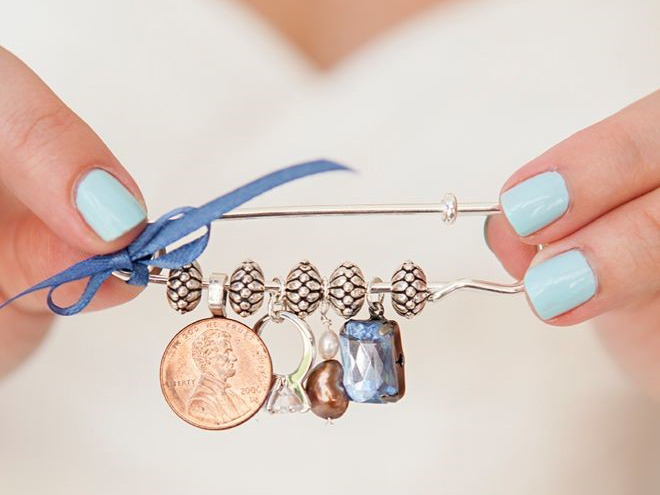Have you ever wondered where all those quirky wedding traditions and superstitions came from? Like the age-old ‘something borrowed, something blue’ rule that even today, most every bride partakes in on their wedding day. We’re taking a look back into the folklore behind these sometimes sweet, sometimes odd customs!
Something old, new, borrowed, and blue
This wedding tradition is one that we are all well acquainted with, but what does it really mean? This British tradition took root from an Old English rhyme – “Something Olde, Something New, Something Borrowed, Something Blue, A Sixpence in your Shoe”.
The four elements carried by the bride as she walks down the aisle all represent good luck charms for a happy marriage. The meaning of each charm has changed over the centuries to suit the modern era however the original connotations stem from the Victorian era.
During this period, the ‘something old’ was used to protect the bride against evil and the curse of infertility. Something new represents the journey you are about to embark on as a newly married couple. “Something borrowed” usually came from a woman who had already given birth to boost the chances of pregnancy which folklore claims will confuse the curse of the Evil Eye into thinking the bride was already with child and counter the misfortune. The “something blue” was often a garter which represented the purity of the bride.

Wearing a veil
Often just thought of as an accessory for the modern bride, the tradition of wearing a veil is said to pre-date wearing white. Before religion, the ancient Greeks and Romans’ used veils to protect and disguise the bride for fear evil spirits and demons would bestow a curse before wedlock.
Seeing each other before the wedding
Following on from the tradition of wearing a veil comes the superstition that it’s bad luck for the groom to see the bride prior to the wedding. A veil hiding the bride’s face also ensured that the groom would not see her face until at the altar.
Unsurprisingly this tradition dates back to when arranged marriages were a common occurrence and the veil would shield the bride’s face until after the marriage ceremony had taken place.
Another reason behind the tradition of the father giving the bride away, other than the antiquated exchange for a dowry, was also to guide the soon-to-be betrothed down the aisle as the veil stopped the bride from being able to see! Today this tradition is solely symbolism for a sweet exchange between the bride and father.
Throwing the garter
Dating back all the way to the 16th Century, the garter was presented to friends and family. This was evidence that the marriage had been consummated! Quite an embarrassing feat in today’s world.
It was also said to be good luck to receive a piece of the bride’s wedding dress. Close guests of the newlyweds would wait outside the bedchamber for the bride and groom to consummate the marriage. This is where the garter came in.
As the custom evolved the tradition became more of a fun wedding reception game. Guests would playfully acquire the piece of fabric. Throwing the garter into the crowd to a group of single men was a way to finish the game. Whoever catches the garter is believed to be the next to marry.
The female equivalent to this tradition is the tossing of the bouquet. Single women would group together and whoever caught the bouquet was next in line to get married.
Cake topper
It’s no surprise that we take heed of the royals when it comes to our wedding day. It’s every bride’s dream to be a princess on her big day. So when Queen Victoria and Prince Albert opted for a miniature sculpture of themselves to top their wedding cake in 1840, the cake topper was born!